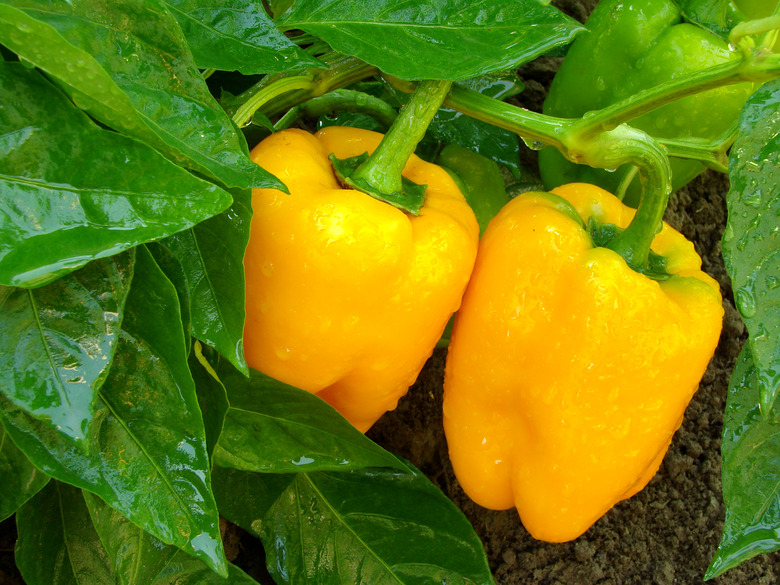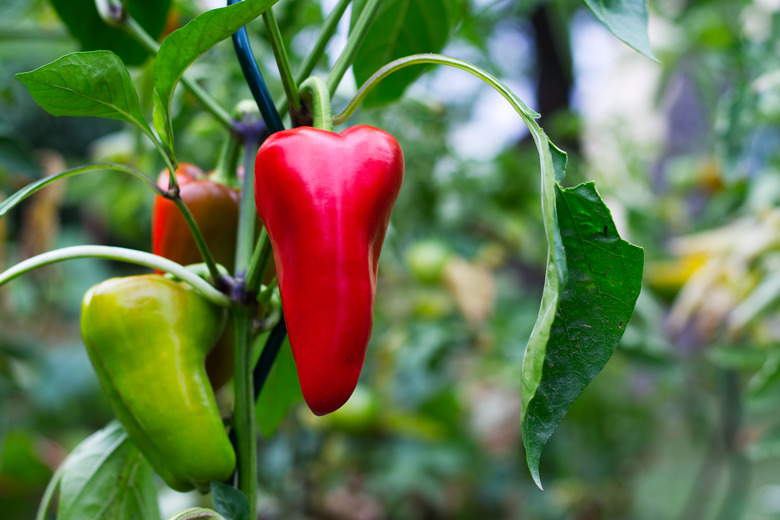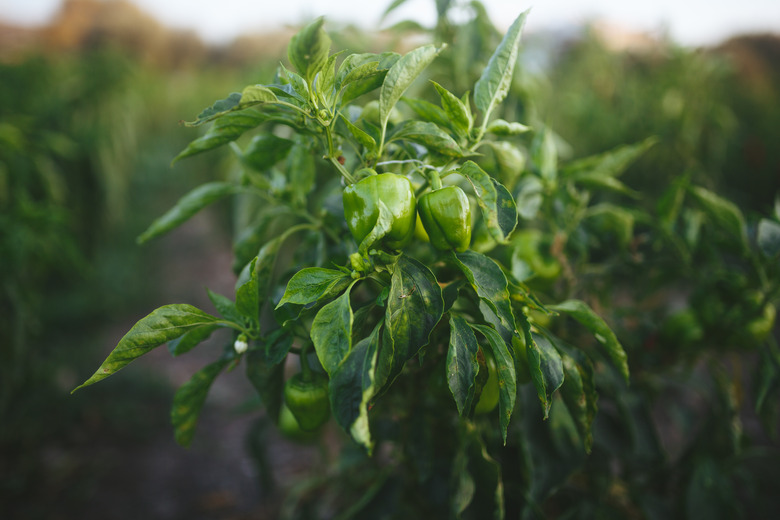How To Grow Bell Peppers
We may receive a commission on purchases made from links.
Bell peppers (Capsicum annuum) are colorful garden vegetables that are easy to grow and are fairly low maintenance. A warm-weather perennial plant in tropical climates, these peppers are relegated to annual status in the United States. They also have a fairly long growing season, and the production of peppers is highly weather dependent. This plant is definitely sensitive to the cold.
Bell peppers come in a number of different colors and have juicy flesh that can taste slightly sweet. Hues include orange, yellow and even purple. Red bell peppers are green peppers that have fully ripened, thus giving them a sweeter flavor profile. Peppers have shiny exteriors and interior seeds that are removed during food preparation. (Technically, this makes them a fruit, although they are typically prepared in ways that make them more of a vegetable in meals. Most people refer to them as such.)
Originally from Central and South America, bell peppers have a number of different varieties. Some of the more popular ones grown in the garden include California Wonder, Olympus, Ace and Bell Boy. Check with a local nursery or online to learn more about the different choices. Some are better suited for certain recipes than others.
Best Uses for Bell Peppers
Best Uses for Bell Peppers
Bell pepper plants can grow up to about 2 feet tall and sometimes even larger. Keep that in mind when mapping out their location in the garden area. Although this plant produces a colorful bounty, it does so late in the season, so it doesn't really make the cut as an ornamental plant. That said, bell peppers can be grown in containers if desired, but they'll need to be close to a 2-gallon size to sustain them. They'll also need to be placed in a location that gets a minimum of six hours of sun a day for them to grow properly and produce to their potential.
Much to the relief of those who prefer milder peppers, this pepper variety doesn't contain the heat-producing capsaicin, which is the substance that makes hot peppers spicy. Bell peppers have a mild taste comparatively and are often used as part of a stir-fry recipe, in fajitas or in pasta dishes. These peppers are also great in salads or on their own as a healthy snack. Stuffed peppers are also a hearty meal, perfect for long, cold winter nights. The colorful variety and delicious taste make them a popular ingredient in many different recipes.
How to Grow Bell Peppers
How to Grow Bell Peppers
- Common Name: Bell peppers
- Botanical Name: Capsicum annuum
- When to Plant: Put seedlings in the ground after final frost
- USDA Zones: Grown as annuals in zones 1-11
- Sun Exposure: Full sun
- Soil Type: Moist, rich, well-drained soil
- When it's in Trouble: Yellow or dark spots on leaves or fruits can indicate fungus
- When it's Thriving: Healthy leaves and firm, shiny, colorful peppers
Starting Bell Peppers From Seed
Since the bell pepper is such a warm-weather plant, starting it indoors is almost a prerequisite for it to do well in the colder growing zones that are located throughout the United States. Plan to work backward eight to 10 weeks from the last frost date in your region and grow from seed in a planting tray. Sow at a depth of about 1/4 inch and be sure to use rich soil that drains well. Bell peppers like a pH somewhere between 5 and 6 or just a bit higher to grow best.
In order for seeds to germinate, they'll need to have temperatures of at least 70 degrees, so a heating pad may be used if needed to get the soil warm enough. Make sure the plants have at least six hours of light or more while growing. Move plants to individual pots as they grow. When they are ready to transplant into the garden, be sure to take the time to harden off the plants gradually to get them prepared for the move outside.
In What Zone Do Bell Peppers Grow Best?
In What Zone Do Bell Peppers Grow Best?
Bell peppers can be grown as annuals in USDA plant hardiness zones 1 through 11, but plants won't make it if the ground gets colder than 65 degrees. Because of this, those in cooler climates may need to make adjustments. One trick that works well is to cover the ground with black plastic sheeting to warm the soil in the early part of the season. Replace this with mulch as soon as possible so the plants don't suffer from collected moisture, which can contribute to fungus, rot and other problems.
In the coldest of climates, it may be smart to grow bell peppers in pots so they can be brought inside if temperatures plummet. Heated greenhouses are perfect for growing bell peppers in cold climates. In very warm climates, be sure to keep plants well watered in the hottest months of the summer season.
When Should You Plant Bell Peppers?
When Should You Plant Bell Peppers?
Bell peppers have a very long growing season, so they need to be planted early in order to allow time for them to mature and begin producing. Generally speaking, this means the earlier the better as long as the soil outside is warm enough for the seedling to survive. Wait until nighttime temperatures are at 60 degrees. As a guideline, the pepper plants take somewhere between 60 and 90 days to ripen, so use that range to help decide the best time to plant given the climate.
Soil, Sunlight and Water Recommendations for Bell Peppers
Soil, Sunlight and Water Recommendations for Bell Peppers
The bell pepper plant likes sunshine, so be sure to plant in a location where it will get full sun throughout the course of the day — at least 6 hours of direct sun. Prepare outdoor soil for the seedlings by mixing in some compost a week or so prior to planting and be mindful not to overdo the fertilizer. Bell peppers are considered to be fairly light feeders. When planting, space the pepper plants 18 to 24 inches from one another. Once plants have flowered, it's fine to supplement with a low-nitrogen fertilizer to encourage further pepper growth.
Bell peppers need well-draining soil, but they also require it to be moist. Aim for somewhere between 1 and 2 inches of water per week. In particularly hot climates, the plants may need to be watered more frequently and may even need to have a little bit of shade to make it through the high temperatures. Even though it is a warm-weather plant, it does feel the effects of sustained heat, so pay attention to the overall appearance and adjust watering and shade if needed.
How to Harvest Bell Peppers
How to Harvest Bell Peppers
Harvesting bell peppers is a pretty simple task. Wait until the pepper reaches its full color and then cut it from the plant with a sharp knife, leaving a little of the stem on the plant. Just take a bit of care to make sure none of the other maturing peppers is disturbed when harvesting. Since the growing season is long, it can be a bit of a wait, but once the plant starts to produce peppers, it's well worth it. If the weather has not been cooperative, it may affect the harvest season, and less peppers may be produced because of it.
Since red peppers are green peppers that have continued to ripen, this will affect the timing of the harvest. In this case, peppers can be removed either when green or when they turn red, which means they will have a sweeter taste and a higher amount of vitamin C. The pepper can be harvested anytime in between as well. Not all varieties of green peppers will turn red, though, so make sure to check the cultivar to see if that is an option in terms of that particular plant.
Common Pests and Other Problems for Bell Peppers
Common Pests and Other Problems for Bell Peppers
Bell peppers are generally a healthy plant with minimal issues. That said, they can be affected by some of the more common garden pests, such as worms, beetles, aphids, thrips and mites. If they are seen, pick off these bugs by hand or give them a good spray with a hose to remove them. It is key to prevent these pests from getting a foothold, as it will be harder to get rid of them once there is a large group.
Be sure to weed frequently around the bell peppers, as weeds provide refuge for mites and other pests. Use a delicate hand to prevent harming the roots of the plant. Mulch can also be helpful to retain moisture and cut down on weeds.
As the plants grow, it can be very helpful to stake them or use tomato cages to help support the peppers up from the ground. This helps reduce moisture buildup and dirt on the peppers and also makes it harder for certain pests to attack. Although this is by no means mandatory, it can make things easier. Keep in mind that staking the plant is pretty much required if it will be grown in a container.
Common Diseases for Bell Peppers
Common Diseases for Bell Peppers
The bell pepper proves to be a hardy plant, as it doesn't succumb easily to disease. Keep a sharp eye out for fungus, which is one thing these plants can be prone to developing. Look for spots on leaves or the peppers as a signal of various potential fungus problems. If it is not caught early, the plant will begin to rot. Completely remove the bell pepper plants from the garden if they exhibit signs of fungus.
Watering at the base of the plant and making sure drainage is ample will help cut down the risk of this disease getting a foothold. In addition, try to place these plants where air circulation is good to cut down on dampness and overall lingering moisture. There are also bell pepper varieties that are engineered to be fungus-resistant. Invest in these plants whenever possible to help avoid dealing with this problem in the first place.


